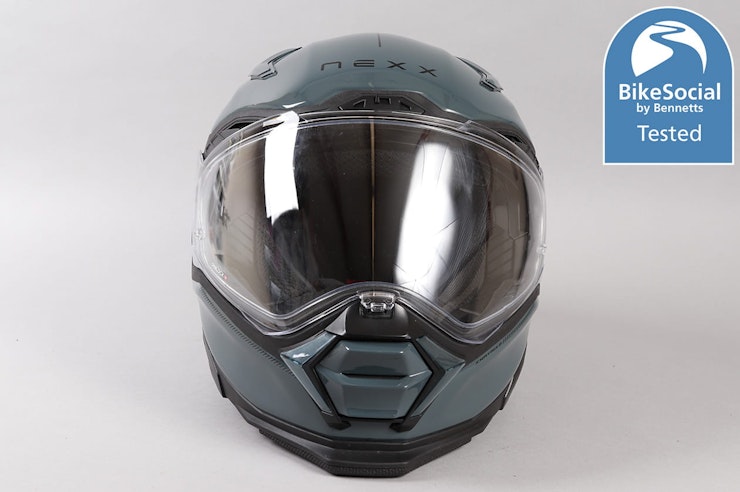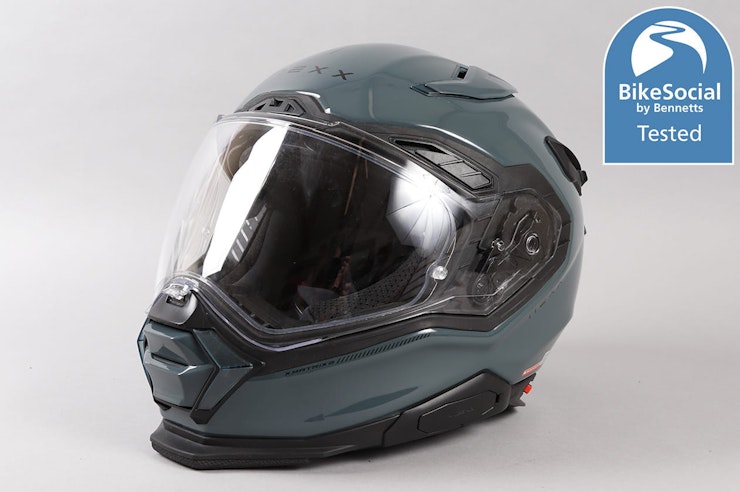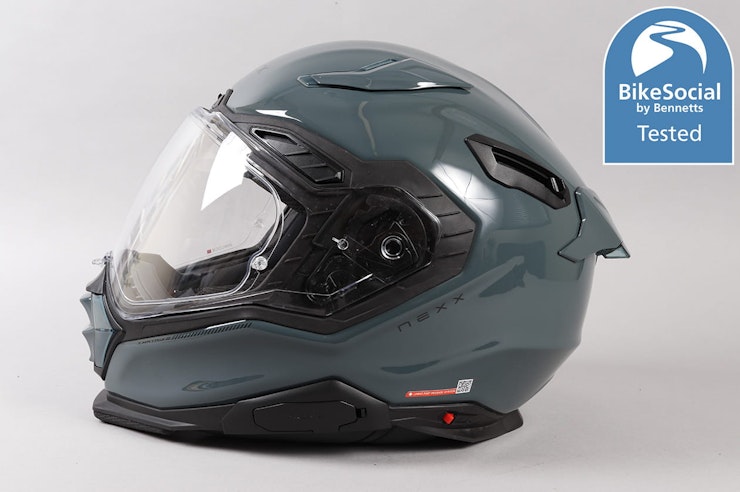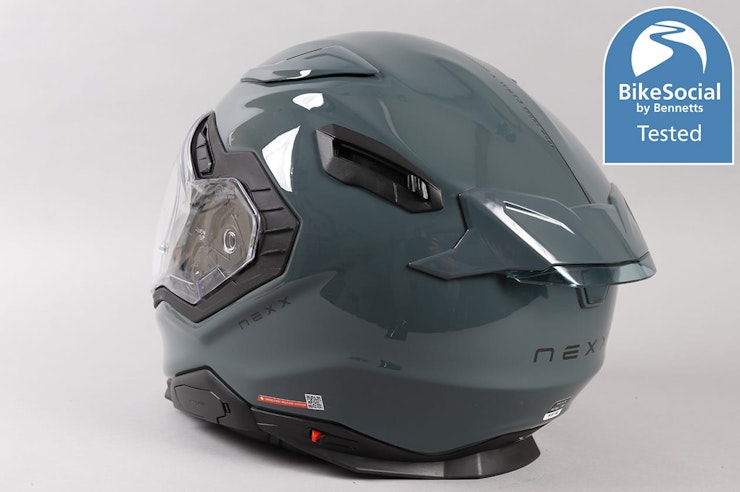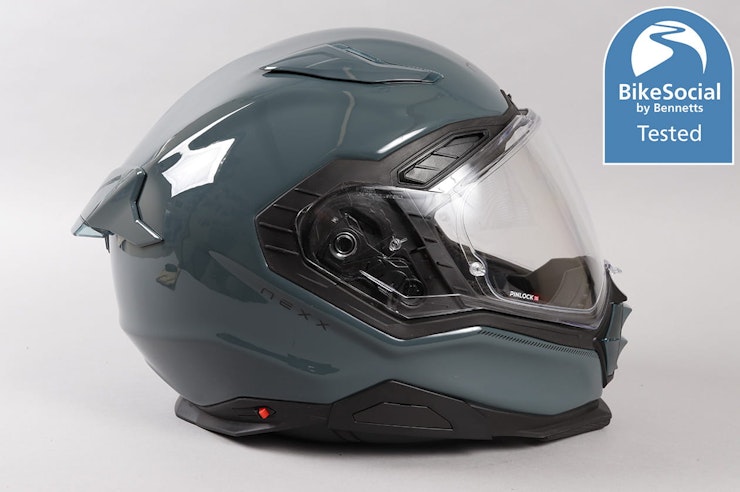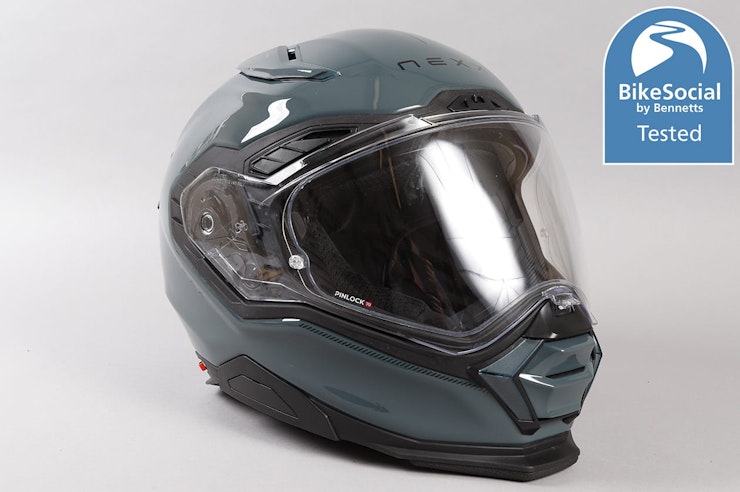Nexx X.WST3 review | ECE 22.06 motorcycle helmet tested
By John Milbank
Consumer Editor of Bennetts BikeSocial
25.03.2024
Date reviewed: March 2024 | Tested by: John Milbank | Price: From £329.99 | nexx-helmet.co.uk
The Nexx X.WST3 on review here is made almost entirely in the company’s Portugal factory – from moulding the shell to sewing the lining – with the majority of parts not made in-house being supplied from companies within a 60 mile radius.
I’ve been wearing this full-face ECE 22.06 motorcycle helnet for around 800 miles on a BMW R1250GS and Zontes ZT350-T, where I’ve found out that it’s certainly not a case of form over function…
Good venting control
Great styling
Excellent visor mechanism
Pinlock can get overwhelmed in one spot
Vents inconsistent at times
Strap a bit long
Which is the best Nexx helmet for you?
Outer shell
This is the ‘standard’ version of the X.WST3, which has a glass-fibre ‘X-Matrix’ shell and starts at £329.99 for plain colours like this lovely ‘Wild Blue’, which is much richer than the ‘Nardo Grey’ that’s on trend at the moment, thanks to its blue tint. The black details are also reflective, which is a nice touch though quite subtle.
‘Fluence’ graphics cost £349.99, then there’s the ‘Zero Pro’, which has a gorgeous plain matt-finish carbon fibre shell and costs £429.99. There are other differences between the Nexx X.WST3 models too…
Finish is excellent, with a deep gloss to the well-applied paint and nice touches like the transparent spoiler on the rear exhaust. Having seen the helmets being almost entirely hand-made, with only automation cutting out the shells and applying the main coat of paint, the price is pretty impressive. I also saw that quality control appears to be on form, with checks throughout the process, and even tiny ‘fish-eyes’ in paint causing completed helmets to be rejected.
The helmet – which is certified to the new, much tougher ECE 22.06 standard – has an aggressive silhouette with noticeable sculpting and distinctive skirts at the front and rear of the bottom edges, reminiscent of automotive design (which is something the team did look at during styling). The chin has a dense foam bumper at the bottom that’s designed to reduce the chances of chest injury in a crash, though if you’re wearing a chest protector it might make looking straight down a little more awkward.
As with any bike kit, try it with the rest of your gear as I did notice that the Rukka Kinglsey jacket – which is particularly bulky at the shoulders, with grippy material and edges in specific places – can catch the bottom of the Nexx when looking to the left or right. With all my other gear it’s fine though.
Included with all the Nexx X.WST3 helmets is a plate that can be mounted to the right-hand side of the helmet, where you can easily stick an action camera. When not in use, a blanking plate covers the screw holes for this. A nice addition for anyone who wants to film their rides, and as it’s an accessory supplied by Nexx, the helmet’s also been tested with it fitted (though not with a camera on).
Nexx X.WST3 Weight
The Nexx X.WST3 weighs 1,767g in a medium in this standard form. Nexx claims 1,640g +/- 50g, and 1,550g +/- 50g for the carbon fibre Pro version. Our test of the X-WED3 in carbon fibre measured it at 1,752g without the peak, but keep in mind that it has additional vents and fasteners.
So it’s not a ‘light’ helmet, but it certainly doesn’t feel heavy in use. All that really matters is aerodynamics, and while some say they can feel a heavy lid when wearing it, I have to say that over almost 30 years, I’ve not struggled with any.
All the ECE 22.06 lids I’ve reviewed have tended to be around 1,600g or so, though it is ironic to see that of the Arais I’ve tested – a brand that was portrayed as being ‘heavy’ in the past (usually by its competitors) – they’re now lighter than many of the others on the market. The £499.99 Arai Quantic, for instance, weighs in at 1,588g on my scales, while the £529.99 Shoei GT-Air 3 weighs 1,678g.
My advice would be to not get hung-up on weight, as when you’re riding there’s often a small amount of lift that means the weight makes far less of an impact than some salespeople might have you believe.
All I would point out is that the more ‘slab-sided’ design of the X.WST3 makes it drag a little more than some others when looking to the left or right at high speed, though not to the point of it bothering me.
Nexx X.WST3 ventilation
Ventilation is good on the Nexx X.WST3, with an open/closed chin vent that feeds up over the visor and straight to the mouth through a mesh vent (without blasting), as long as air can reach it behind your bike’s screen. A blanking insert is supplied if you want to close this, but do watch when you carry the lid as it’s easy to push the mesh or blank into the recess. Resetting it is simply a matter of popping out the large orange X-shaped cover inside.
Inside the visor are inlets on either side of the cheeks that feed vents going through the cheek pads to help keep them cool. I’ve not noticed a difference, but allowing air to move here makes some sense, and with the visor open it could help draw a touch more warm air away. This is the same as on the adventure-styled X.WED3, where they’re likely to be more effective with googles on and the visor removed.
At the brow, directly above the visor, are three more vents. The centre one is easy to operate but a bit small, while the ones on either side are a touch trickier to move.
It’s not immediately obvious what these do as behind them is the gap for the drop-down sunshield, though there are very slim ports that should direct some of this air down, onto the back of the visor at the top. As long as the wind is hitting them, I can feel a slight difference across my face.
The top of the lid features two inlets that become noticeable when turning your head to either side while riding some bikes and the screen deflects the air straight into them, but mostly there’s no obvious breeze, the air potentially also moving between the inner and outer shells. You can hear them working at time; the way my R1250GS standard screen hits them (I’m 5’10”) creates a little extra noise when they’re open.
Several ports inside the EPS liner appear to feed the exhaust vent on the rear, though using a torch to check, it appears that only two of them are doing the most work. It’s worth remembering that this helmet shares a lot of parts with the X.WED3, which has more vents on the outer shell to work with so can move more air around.
Arai set an incredibly high benchmark with the Quantic’s venting, but of course it doesn’t have a drop-down sun-shield to contend with like the X.WST3.
Nexx X.WST3 visor
I love the Nexx visor removal mechanism on both this and the X.WED3 (they’re both exactly the same) – open it, slide the lever and it just pops off. Putting it back is just as simple… simply locate the pin then click it back in. Brilliant.
There’s an excellent field of view from the Nexx X.WST3 visor, both up and down and left and right, the supplied Pinlock 70 (120 on the Pro model) also giving a wide field of view.
The visor can be cracked just off open with the centre tab, and also sports left and right tabs for plenty of options when adjusting it off lock. There are three open positions, and I’d have liked to have had one lower down, that held the visor about 1cm open, as the first stage puts the bottom of the visor just below your eyeline.
Something I’ve noticed with this helmet is that my glasses seem less prone to steaming up than in many other helmets, maybe due to the more roomy chin area. However, I have found that the Pinlock can get overwhelmed in one spot when riding in cold, damp conditions.
At 7°C, riding for 1.5 hours in the rain on back-roads with the visor closed, chin skirt fitted but chin and brow vents open, the area around my nose at the base of the visor misted. This was on the surface of the Pinlock, so easily wiped away and proves it was sealing properly, but more importantly this didn’t spread. It’s annoying, and Ben found it happened with his X.WED3 too, though in my testing the 120 Pinlock supplied with the Pro versions does seem to suffer with it less, as you’d expect.
I’ve tried various combinations of visor openings and chin skirt in and out, but in the right (or wrong?!) conditions, this localised misting still occurs. As the weather’s warming up though, it seems to have stopped.
A drop-down sunshield is fitted to the Nexx X.WST3, which works very well and is easy to operate with the left hand. It comes down to a good level, leaving no distracting gap of light along the bottom edge, though I find the nose aperture to be a bit bigger than necessary, allowing some light to get in here. So not the very best drop-down I’ve used (well done Shoei GT-Air 3 / Neotec 3) but certainly not far off.
Nexx X.WST3 lining
The Nexx lining uses ‘X-MART DRY’ fabrics that are claimed to be anti-allergic and anti-sweat. I’ve not been getting sweaty in this yet, but it is a very comfortable liner, and it’s impressive to learn that it’s entirely made by Nexx in Portugal.
Removing and refitting the lining is fairly easy for cleaning once you get the hang of the unique quick-release mechanism that has a slider on either side to release the cheek pads.
Meant in part as a safety feature to allow emergency responders to remove the pads and lift the helmet clear more easily, there’s just a small QR code label on only one side to help anyone not familiar with the system. Scanning that QR code takes you to an advice page on the Nexx Website. From there you have to select the region you’re in, then there’s a list of options for all the lids, so an emergency responder would need to know the model. After that, you have a drop-down menu that starts with ‘how to remove the [goggles] strap holder’. The fourth one is ‘Remove lining’. Click on this and it takes you to a YouTube video about lining removal. After an advert, you can watch how to do it. I really hope that Nexx changes this QR code to link to a very clear, simple step-by-step photo guide that comes up instantly when viewing, without any further clicks. It’d also be good to have that label on both sides, and made of a more resilient material.
Fastening
The double-D ring strap fitted to the Nexx X.WST3 is surprisingly long – I can’t imagine anyone needing this much – and while I prefer a micrometric ratchet fastener for speed and ease of use, the double-D does always ensure a secure fit when pulled tight.
This ‘standard’ X.WST3 has a popper on the end of the strap to stop the spare flapping about, and all I’d change is to not have as much excess after the popper. The ‘Pro’ carbon-fibre version has a magnetic retainer with a large pull tab, which snaps into place easily but makes it harder to pass through the D ring. I prefer the popper.
Nexx X.WST3 fit
Fit is entirely subjective, but I found the X.WST suited my medium-sized head well, only causing a bit of pressure at the front at first, and feeling a little snug at the ears. Over long rides, this can get painful on the front, due to the ridges in the EPS behind the brow padding. I've since pressed this down a little to help relieve the pressure a bit. You must always try any helmet on for yourself before buying, and check carefully for any pressure points, which can get painful after a while when riding.
Importantly, the Nexx hugs all of my head well and never feels like it wants to move, even at high speed.
As a glasses wearer, I’m pleased to say that my specs tuck in fine, and they remain comfortably sat on my nose.
Nexx X.WST3 noise
Noise is incredibly hard to assess fairly as it’s so dependent on your bike. In clean air, the Nexx X.WST3 is an average-to-good helmet for wind noise, and on the R1250GS it’s only the vents that seem to pick up some noise when open.
On the Zontes I noticed a bit more wind noise, but it really is going to depend on your bike.
Whatever you ride and whatever you wear though, over about 40mph you must use earplugs.
For more information on why earplugs are vital with any helmet, and advice on which are the best, click here.
It’s possible to fit most intercoms, but the Nexx X-COM3 is very impressive
Can I fit my own intercom to the Nexx X.WST3?
Despite the heavy sculpting, there’s space for an intercom just below the rear of the visor mechanism on the left of the Nexx X.WST3, though the cables will have to run about 6cm down the side.
The speaker apertures inside the helmet are 48.5mm in diameter and approximately 14mm deep (if you remove the glued-in foam, which accounts for about 6-8mm), so no problems there, and you should be able to tuck the mic into one of the corners beside the removable X-panel in the chin.
The easiest way would of course be to use Nexx’s own intercom, which is made by Sena. I’ve reviewed the Mesh and Bluetooth X-COM3 Pro here at £339.98, though there’s also a Bluetooth-only version at £169.99.
Four alternatives to the Nexx X.WST3
The Nexx X.WST3 has distinctive styling that many will love, and it’s fairly well priced, but here are some alternatives…
Ruroc Atlas 4.0 | RRP From £259. The Ruroc is in some ways similar thanks to its aggressive styling, but it’s simply not as good. A combination of fake vents, a poor chin strap and an EPS liner that pokes out of the visor aperture make this very hard to recommend. Read the full review of the Ruroc Atlas 4.0 here.
Nexx X.WED3 | RRP from £329.99. If there’s the slightest chance you’d like to have a peak on your helmet in future, consider the adventure version of this helmet, which has more vents and can be used with or without the peak. As it starts at the same price as the X.WST3, it’s potentially the wiser buy thanks to its versatility. Read the full review of the Nexx X.WED3 here.
Arai Quantic | RRP From £449.99. The benchmark in sport-touring helmets, it does have a big wing on the back but it’s not as aggressive-looking as the Nexx. It has outstanding venting, but no drop-down sunshield, which will be a deal-breaker for some. Read the full review of the Arai Quantic here.
Shoei GT-Air 3 | RRP from £529.99. A superb full-face sport-touring helmet that includes a drop-down sunshield. Pricey, but nicey. Read the full review of the Shoei GT-Air 3 here.
These are just four of many alternatives – you can find all the motorcycle helmets we’ve tested here and be sure to regularly check for the discounts available through Bikesocial membership.
Nexx X.WST3 review: Verdict
There are of course lots of options out there of helmets around the same price or lower than the X.WST3, and you’ll find many of them here. But the fact that the Arai and Shoei were the first to jump to mind as competitors is perhaps telling of the quality of this lid.
The Nexx X.WST3 isn’t perfect, but it does offer a lot for the money, especially when you see the amount of work that goes into it entirely by hand in Portugal.
The Nexx X.WST3 is definitely worth trying on when buying your next helmet, but I would recommend you also look at the X.WED3, which starts at the same price and gives the option of riding with a peak if you want it.
If you’d like to chat about this article or anything else biking related, join us and thousands of other riders at the Bennetts BikeSocial Facebook page.
